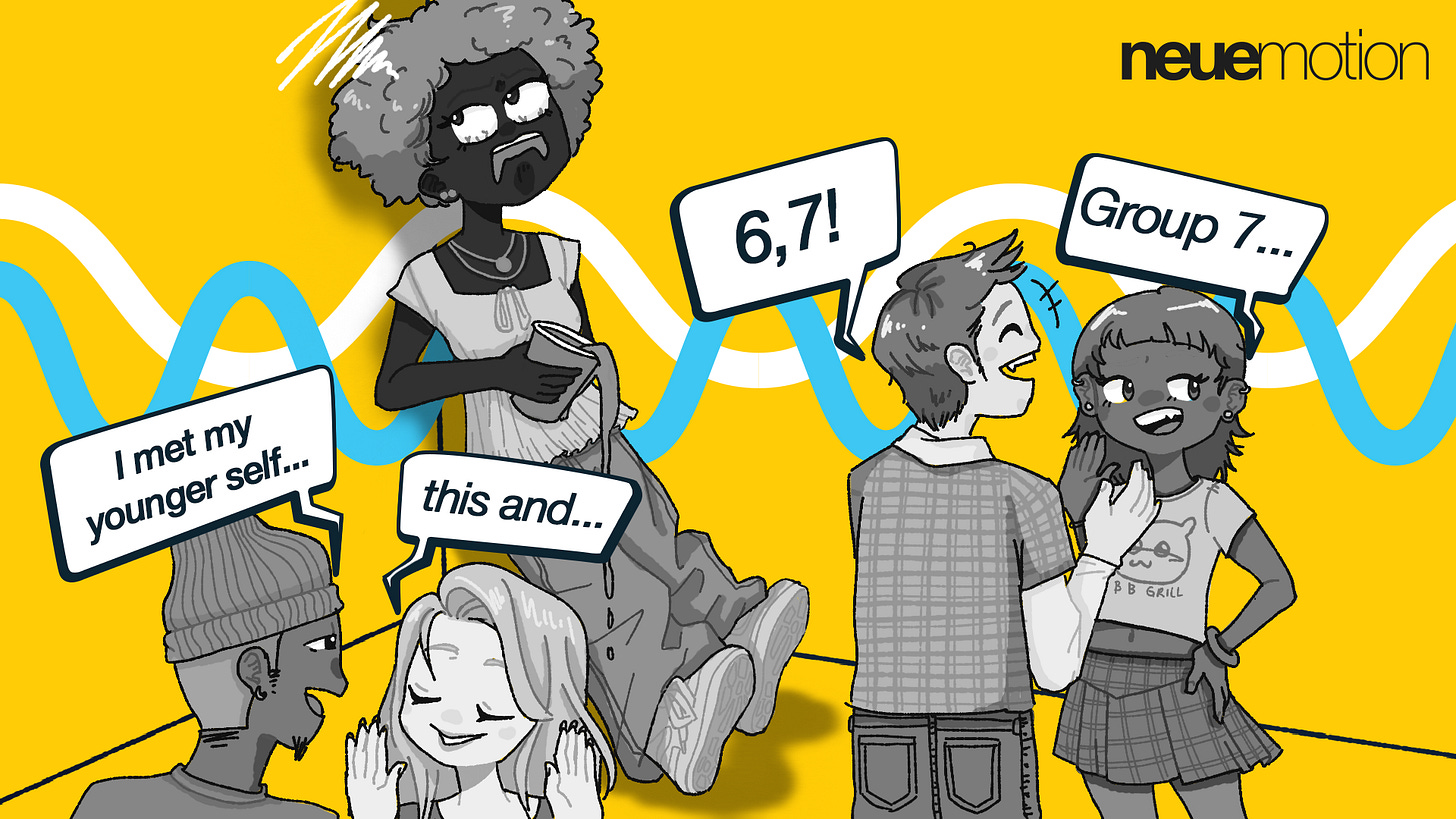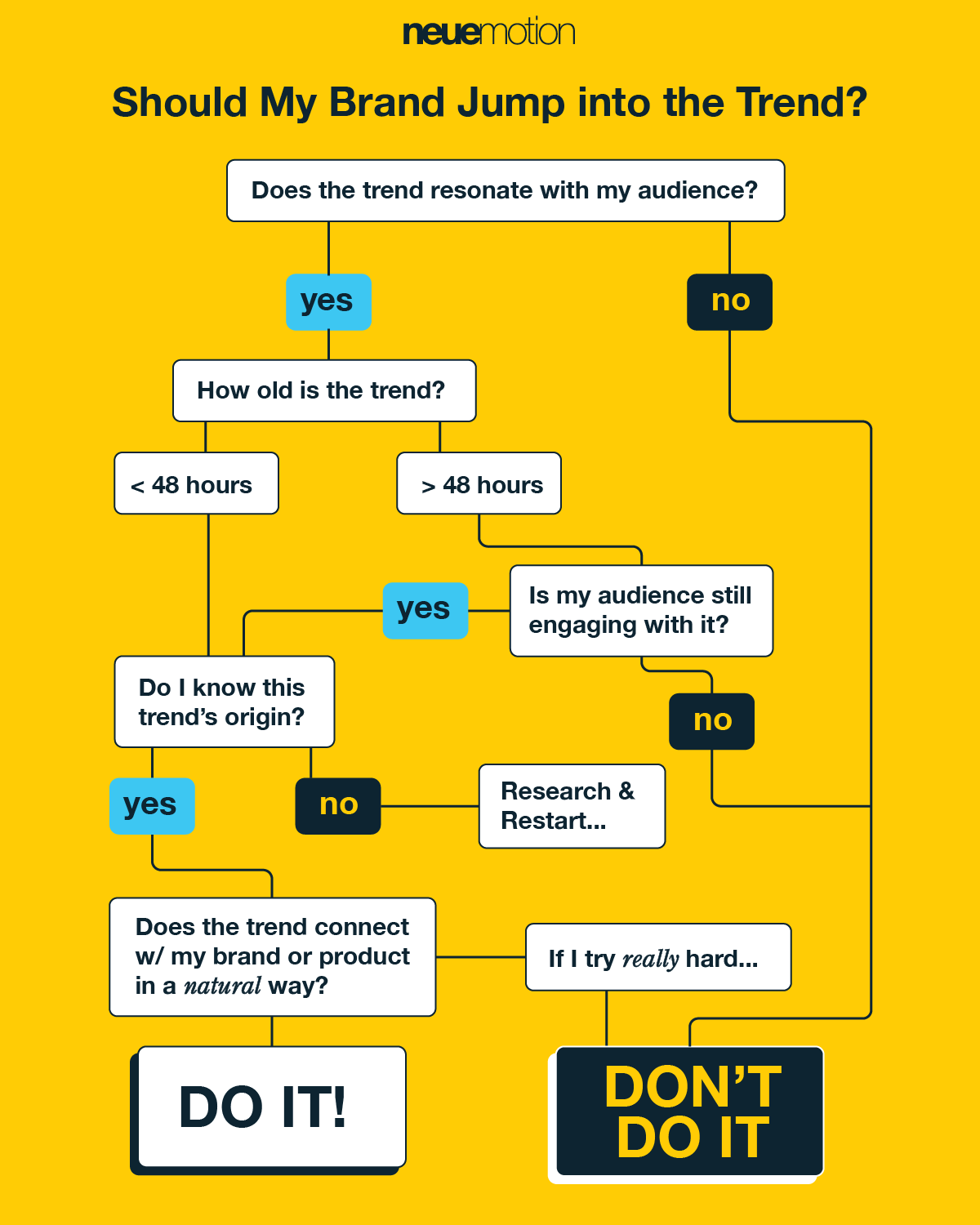The Trend Tipping Point
Did your brand just kill the trend cycle?
We all know how a trend starts, and we all know the exact moment it dies.
A creator—most of the time a small creator—makes something cool, engaging, and interesting.
Internet users instantly love it and want to make the it their own.
Fire catches, the trending format, feature, or phrase has now permeated swaths of feeds.
Then… a brand does it.
….
Something that felt novel and connective has been commandeered and watered down to sell you something.
The first few to do it are usually met positively, with comments full of “your marketing team needs a raise!” for their swiftness.
But then, so many brands and entities jump into the trend that it begins to leave a sour taste in the mouth of the internet. A cynical groan replaces the simple joy.
The bitterness leads everyone to abandon it. Anyone doing it after we have publicly discarded it now being seen? At best: late to the game. At worst: cringeworthy.
The original creator is abandoned with whiplash in the carnage as the next trend begins to take form, and so the cycle begins again.
The real danger for brands is not missing the trend, but misjudging the exact moment their involvement turns from being a welcome connective vehicle to their community, to a misstep that leads audiences to side-eye their brand. The decision to participate has become a high-stakes gamble..
Brands Have to Keep Up
For brands, the pressure to keep up with social trends and cultural moments is all too real. The 2025 Sprout Social Index found that 93% of consumers believe it’s important for brands to keep up with online culture. This expectation creates immense pressure to be “in the know”, and quickly rising trends are seen as the perfect vehicle to demonstrate this cultural cachet. The brand’s desire to participate in culture quickly clashes with the consumer’s desire for that culture to remain authentic and untainted by the business world.
The “Group 7” meme/movement this fall is a case study in brands responding to the pressures of quickly rising trends without tapping into the real meaning of the trend to begin with.
From musician and creator Sophia James, The Group 7 phenomenon relates to a series of posts in which James meant to test how users were seeing her content, organizing them into batches or group numbers for easy identification. While all of her “groups” of content have now surpassed a million views, Group 7’s video became the biggest hit, with over 84 million views and counting. The camaraderie and engineered social status associated with being in the “winning” Group 7 created a ripple effect permeating content and comments alike.
Many assumed that by jumping on the trend carousel, they could show their online cultural awareness. If everyone is talking about Group 7, why don’t I, Jersey Mikes, also talk about Group 7? But trends are merely a part of online culture, not the whole thing, and simply contributing to trends without the larger cultural context is where a trend can go from being fun, to toppling the tipping point that leads to the eyerolls and abandonment.
... But it’s Just So Embarrassing
Just because consumers expect some level of participation doesn’t mean they always like all participation. While brands are encouraged to keep up with online culture, a third of consumers think it is embarrassing when a brand actually does it. The joys of being part of Group 7 quickly turned into a familiar, cringey feeling we get when brands try to wade into any social movement they don’t belong in. To the brand, they think they are connecting themselves to a cultural moment, but to users, it feels like they’re infiltrating something special and connective that they didn’t understand in the first place (cue the aforementioned cynical groan).
The embarrassment users feel for brands comes when the perceived awareness of the brand falters. It’s projected onto brands when, in an attempt to demonstrate their cultural awareness, they miss the boat or the point altogether. This doesn’t make users feel connected to your brand; it makes your brand appear as though it’s trying too hard and failing spectacularly.
What Tips the Scale?
How do we identify this tipping point? Where does it begin? Somewhere between the timing, the trend, and your brand lies the answer.
The lifespan of a trending moment is very real, and very short. When asked if they like when a brand participates in online trends, 27% of participants said that they only feel it is effective when it is done within 24-48 hours of the trend’s creation. Urgency is essential. But as always, there is nuance.
The intention of a trend can influence its effectiveness window. Naturally, humor is all about timing– jump into a funny trend too late, and the cringe is unanimously felt. However, some of the more wholesome or inspirational trends, such as the “this and…” format, have become more evergreen formats that can live a longer lifespan, while larger cultural moments that create viral trends, like the many that came from Love Island this summer, can live longer than that 48-hour window. However, whenever a brand jumps in when the trend feels like it has passed, it will always evoke the collective cringe, regardless of the genre. This means knowing how and when your audience is interacting with it can be your north star to determine your own participation.
A trending moment’s lifespan is also tied to its authenticity—not just how real it feels to those jumping in, but to the content itself. When a trend gets recycled too many times, or worse, strays so far from its roots that its original audience can’t recognize it, it risks becoming completely meaningless. It gets watered down by sheer repetition and an ever-widening circle of users who are too far removed from the spark that started it all.
We saw this play out with the “I met my younger self for coffee” trend earlier this year. It was started by a poet and digital creator as a heartfelt way to promote their new book. A small, growing niche of writers and online romanticizers felt instantly inspired, writing their own moving versions of the poem. Yet, as the trend grew and was shared outside of this close-knit circle, the original, vulnerable intention began to fade. The format remained intact, but the content became something else entirely. Once bigger influencers used it simply to promote their platforms, or when creators injected dark or overly humorous twists, the trend hit its tipping point—leading to its swift and total abandonment by the online community.
Once a piece of content or behavior crosses the boundary of its original audience, the trend begins to lose its specific meaning and context that made it impactful in the first place. This moment is when the trend is most susceptible to being co-opted or diluted, especially when commercial brands participate.
Certain trends lend themselves well to brand participation, but the brand’s established identity and their audience is the most important indicator on whether it will help propel the trend on, or tip its scales to the point of no return. When a brand’s participation respects the trend’s original context and aligns with their established audience—such as Duolingo using cultural moments to provide character-driven, absurd content to connect with their dedicated audience, or Beis using trends as a vehicle for their established aspirational travel aesthetics—it doesn’t tip the scales. Rather, it validates and amplifies the trend (and the brand’s cultural position) because it is additive to the content their audience already knows and loves. Conversely, when a brand jumps into a trend that originated from a cultural context far removed from its own, it leaves everyone feeling like the brand has arrived at a cultural event to which it was never invited.
To Participate, or not to Participate…
Ultimately, a brand must walk a painfully thin line: it seeks the glow of cultural relevance without being perceived as an intruder attempting to hijack the connective tissue of trends that bridge the gaps of online communities.
The issue isn’t whether brands should engage, but how and when. This means engagement cannot be impulsive, but strategic: taking stock of a trend’s origins, tracking its place in the life cycle, and assessing its alignment with your brand’s identity and voice. This crucial step determines everything. By doing your homework, you ensure your participation in the right trends acts as a validation to the community; fail to do so, and your brand risks becoming an unintentional perpetuator of the trend tipping point—the moment the internet decides you’ve taken too much, and thus abandons it, and you, altogether.




